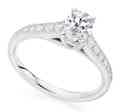ANATOMY OF AN OVAL SHAPE DIAMOND

About The Oval Shape
The oval shape diamond offers a refreshing alternative to people who want something a little different. With its elongated shape, oval diamonds whisper an air of elegance that no other shapes display.
One of the key advantages of selecting an oval diamond is that it faces up larger than other diamonds with similar carat sizes. Also, it can flatter the fingers by making them appear longer and slimmer (perfect for women with smaller sized hands or shorter fingers).
As with a marquise cut, it tends to flatter the fingers by making them appear longer and slimmer.
The Bow Tie Effect
By nature of their faceting structure, oval diamonds have an intrinsic bowtie effect. These are dark areas which resemble a bow tie which can be seen from the face up view.
This characteristic is created as a result of pavilion facets that cause obstructions to the light when a person looks at the diamond.

Typically however, ovals with shallow depths below 57% tend to display unattractive bow tie formations.
It is therefore important to check the diamond does not display strong visual evidence of this bow tie phenomenon.
Cut
Although not formally defined within a grading report, the overall majesty of an oval diamond, as with a round brilliant, is materially defined by the quality of it's cut.
Even with excellent proportions and symmetry, anything less than a very good cut will really detract from it's appeal.

Preferred Proportions
Modern oval diamonds are cut with various types of faceting patterns and this results in ovals with vastly different appearances.
Dimensions including percentage table and depth, and length-to-width ratios impact how the diamond looks and how much light it reflects.
As a guide, the ideal table should be between 53% and 59%, and no less than 51% or much greater than 61.5%.
Depth of 59% to 67% is very good, with the sweet spot between 61% and 66%.
Symmetry
With these longer shapes, symmetry is a priority, especially in larger carat stones.

It is therefore advisable not to go for a stone with anything less than Very Good Symmetry and, if budget allows, worth paying up for Excellent.
Length To Width Ratio
The ideal length-to-width ratio is generally considered to be between 1.20:1 and 1.42:1.
Although to a large degree a matter of personal taste, the absolute ideal is around 1.32:1 which gives the diamond a classic oval shape.

If the ratio is much below 1.20 then the stone can look more like a badly proportioned round cut diamond.
Much above 1.42 and it starts to take on the appearance of a round edged marquise cut.
Colour & Clarity
Any minor marks or inclusions found in the middle of the stone will not be so clearly visible in an oval diamond as it is in many other shapes. It is therefore not necessary to pay a premium for a clarity grade above VVS2.
As a function of the large surface area of the stone, the diamond colour tends to be more detectable. In this regard, we would advise against choosing an oval diamond with a colour grading below H.
In summary, If budget allows, we would guide towards an oval shape, eyeclean diamond with a ratio between 1.20 and 1.42, with colour to /G and clarity VS1 to Si1.


